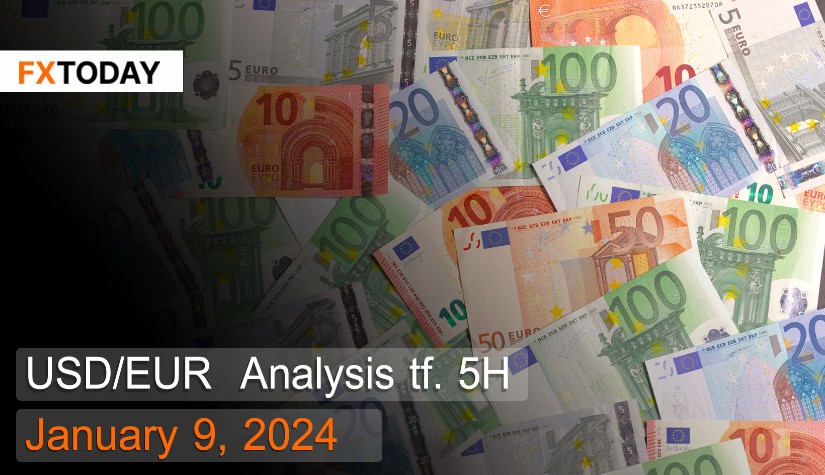The Eurozone economy remains fragile due to the rise in interest rates.
The Euro has stabilized at around 0.91 euros per US dollar, as investors perceive that inflation in the Eurozone is increasing alongside the robust US labor market. This scenario helps to prompt both the European Central Bank and the Federal Reserve to start adjusting interest rates more swiftly. In December, the inflation rate in the Eurozone increased to 2.9%. Simultaneously, the US added 216,000 jobs, surpassing market expectations of 170,000, while the unemployment rate remained stable at 3.7%.
The Eurozone's inflation rate rose again by 2.9% year-on-year in December, marking the first increase since April. This was driven by higher energy prices in December. However, service sector inflation remained stable at 4.0%. Additionally, a significant factor contributing to the increased inflation rate was the rise in food and beverage prices, which surged by 6.1%. The underlying inflation rate, excluding food and energy prices, slightly decreased to 3.4%, signaling some positive aspects.
The Producer Price Index (PPI) contracted to 8.8% year-on-year in November, down from 9.4% the previous month. This indicates a moderate ability to increase prices for goods. Energy prices decreased at a slower rate of 23.7%, while the cost for goods decreased by 5.3% due to the slight slowdown in the inflation rate for goods at 3.1%.
The Economic Sentiment Index in the Eurozone increased to 96.4 in December, reflecting an overall more positive sentiment across all sectors. Despite the anticipation of higher inflation, the main reason for optimism remains the expected interest rate cuts. Confidence among manufacturers increased to -9.2, and consumer confidence rose to -15.0. When compared on a country-by-country basis, Germany showed the most significant increase in confidence at +2.4.
Retail sales in the Eurozone fell by 0.3% month-on-month in November, attributed to decreased household spending ability, resulting in reduced retail trade volume. Sales of food and beverages decreased by 0.1%, and other non-food products decreased by 0.4%. This affected online retail sales, which contracted by a rapid 1.2%. Germany was particularly impacted, experiencing a 2.5% contraction in domestic retail trade.
The Purchasing Managers' Index (PMI) for the construction sector in the Eurozone increased to 43.6 in December. Despite a generally resilient outlook, companies continued to reduce activity due to reduced new orders and a high inflation rate for raw materials. This necessitated a reduction in purchases related to construction, as well as a reduction in hiring. Confidence in this sector remains pessimistic regarding future activities.
Techical analysis data (5H)
Resistance: 0.9138, 0.9143, 0.9153
Source: Investing.com
Buy/Long 1: If the price touches support in the price range of 0.9113 - 0.9122 but cannot break the support at 0.9122, you may set a TP at approximately 0.9143 and SL at around 0.9107 or according to your acceptable risk.
Buy/Long 2: If the price breaks the resistance in the price range of 0.9138 - 0.9143, you may set a TP at approximately 0.9153 and SL at around 0.9113 or according to your acceptable risk.
Sell/Short 1: If the price touches resistance in the price range of 0.9138 - 0.9143 but cannot break the resistance at 0.9138, you may set a TP at approximately 0.9113 and SL at around 0.9153 or according to your acceptable risk.
Sell/Short 2: If the price breaks the support in the price range of 0.9113 - 0.9122, you may set a TP at approximately 0.9107 and SL at around 0.9143 or according to your acceptable risk.
Pivot point January 9, 2024 02:13 PM. GMT+7
| Name | S3 | S2 | S1 | Pivot Points | R1 | R2 | R3 |
| Classic | 0.9107 | 0.9113 | 0.9122 | 0.9128 | 0.9138 | 0.9143 | 0.9153 |
| Fibonacci | 0.9113 | 0.9119 | 0.9122 | 0.9128 | 0.9134 | 0.9137 | 0.9143 |
| Camarilla | 0.9129 | 0.9130 | 0.9131 | 0.9128 | 0.9134 | 0.9135 | 0.9137 |
| Woodie's | 0.9109 | 0.9114 | 0.9124 | 0.9129 | 0.9140 | 0.9144 | 0.9155 |
| DeMark's | - | - | 0.9125 | 0.9130 | 0.9141 | - | - |
















